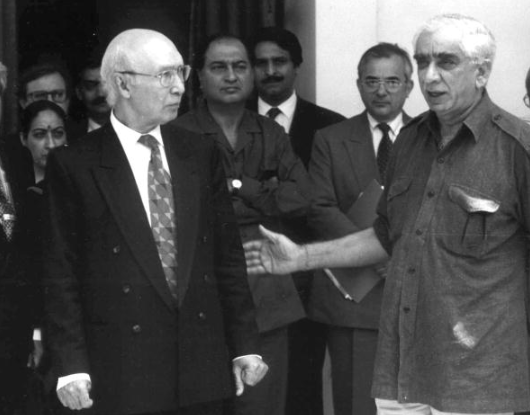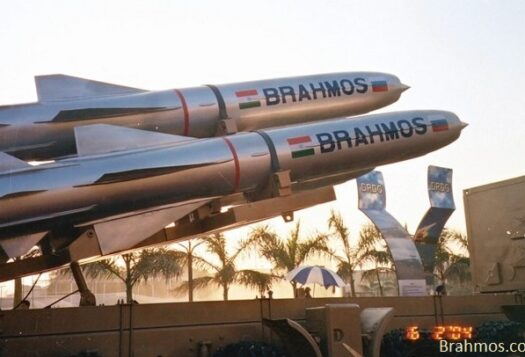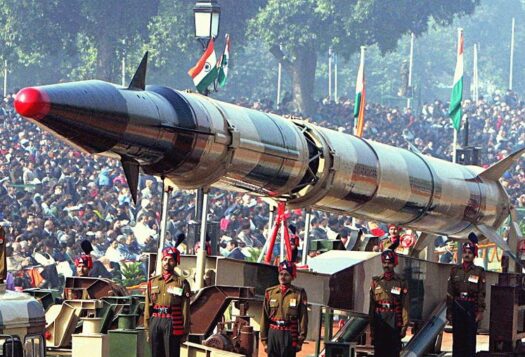
Nuclear South Asia attracts frequent international attention owing to the rivalry between the nuclear armed states, unresolved disputes, porous borders, and recurrent crises. These crises have been a serious preoccupation of strategic studies analysts, who all too often frame these regional crises in terms of bilateral deterrence frameworks. The United States has tended to be involved in these crisis, pressing each side to step back from the brink. However, this involvement has not been theorized in a trilateral framework to understand the crisis decision-making process. Moeed Yusuf’s new book Brokering Peace in Nuclear Environments: U.S. Crisis Management in South Asia (Stanford University Press, 2018) breaks new ground in presenting a theoretical framework of three-cornered brokered bargaining to understand the behavior and decisionmaking of nuclear-armed states during crises.
Brokered Bargaining Framework
Yusuf’s objective is to understand and lay out how the tri-cornered model is able to achieve de-escalation, for informed readers and the policymakers alike. The theory of brokered bargaining explains the pattern of behavior of states during crises and how these states interact with a third party, the “unipole.” The unipolar power enters the fray to keep the regional rivals from stepping off the brink, irrespective of its broader foreign policy goals and in connivance with other major powers, with the use of positive inducements and threat of punishments to help achieve de-escalation.
The model posits that the nuclear rivals demonstrate a mix of signaling aimed at the antagonist as well as the third party in order to achieve their crisis outcomes. This signaling is a mix of “resolve” and “prudence”: the signaling of resolve is to exhibit the seriousness of intent to the antagonist in achieving the crisis objectives and the prudence is to avoid being overly risk prone in a nuclear environment and to remain sensitive to the third party’s preference. Above all, the three-way interaction is a process-oriented approach in determining the behavior of the regional rivals amongst themselves and vis-à-vis a third party as the latter helps de-escalate the crisis. The interplay of these “perceptions, expectations, incentives, strategies amongst the three parties” not only affects their overall behavior, but also determines stability and the outcome of the crisis.
A Novel Approach
The analysis presents a novel approach, as it breaks away from the traditional framing of nuclear rivalries in bilateral deterrence contexts by introducing the third party influence on the behaviors of the antagonists as they strive to achieve their desired crisis outcomes.
The analysis presents a novel approach, as it breaks away from the traditional framing of nuclear rivalries in bilateral deterrence contexts by introducing the third party influence on the behaviors of the antagonists as they strive to achieve their desired crisis outcomes. The theory does not undermine the logic of nuclear deterrence. However, while operating at a deeper structural level, it posits that the understanding of the crisis behavior of regional rivals is possible only if studied as a three-way interaction with ample emphasis on the roles and leverage exercised by the third party in facilitating de-escalation.
Another key feature of the book is its incisive account of past crises in South Asia, which provides insights into learning about the crisis behavior of South Asian nuclear rivals in the first decade of nuclearization. The author tests the empirical foundations of the theory on the South Asian nuclear rivalry in the past three crises of the post-nuclearization era: the 1999 Kargil crisis, the 2001-02 standoff, and the 2008 Mumbai crisis. The analysis provides a useful aide to the policy-makers involved in crisis decisionmaking and can help them in deconstructing the complex signaling and behavior manifested in future crisis situations.
Busting Popular Myths
Yusuf’s work unravels some popular myths related to South Asian crisis understanding; for instance, the notion of an “impartial broker.” The literature on mediating South Asian disputes and crises is rife with references to brokering peace with an impartial mediator while claiming that the United States is a partial broker and hence not suited for the role. Yet, Yusuf’s analysis of the crises brings forth different findings. He asserts that Pakistan’s continued engagement with the United Sates in the Mumbai crisis—at a time when it was deeply suspicious of the United States and India’s overbearing reliance on U.S. diplomacy—regardless of its underlying mistrust of the United States as an impartial broker, is counterintuitive.
Interestingly enough, evidence demonstrates that contrary to India’s stated policy of aversion to third party mediation, it worked proactively to involve the United States and seek concessions from it during the 2001-02 stand-off. India also used the aftermath of Kargil episode to attract international sympathy by convincing world powers to pressure Pakistan and portray it as an irresponsible nuclear power. This led the United States to pressure Pakistan and successfully elicit a statement from General Musharraf to close and ban the jihadi training camps in Kashmir. Absent the brokered bargaining framework, this episode might look more like the success of India’s coercive diplomacy.

Exploring the Limits of Brokered Bargaining
The model of brokered bargaining is based on the third party (unipole) alternatively imposing costs or leveraging concessions when solicited, to achieve de-escalation. However, the framing of the third party as a unipole constrains how the model can be applied to other regional crisis where the United States, irrespective of being the unipole, would be a party to the crisis rather than act as a third party. For instance, in Korean peninsula, the third party role can only be effectively played by China and not the unipole, as the latter would be a direct party to the crisis if North Korea were to threaten it with nuclear weapons.
A key proposition in the brokered bargaining framework that shapes the third party’s crisis behavior is the role of the other “strong powers” that “align their interests with U.S. efforts to ensure de-escalation” (p. 32). In an era of strong alignments, such a convergence of objectives among United States and other strong powers may be hard to achieve, and this might complicate management of future crises. The current trends in U.S. policy depict that it is increasingly moving away from multilateralism to that of an “America First” approach to international politics. Going forth, it remains to be seen how this affects its coordination with other major powers in complementing the crisis de-escalation objectives of the United States.
Peace is not the mere absence of war, hence the prevention of crisis from escalating into war cannot be considered as synonymous with the brokering of peace. Crisis management, though a tactical gain, ultimately becomes a strategic loss, as broader U.S. foreign policy objectives do not promote broader strategic stability in South Asia.
Peace is not the mere absence of war, hence the prevention of crisis from escalating into war cannot be considered as synonymous with the brokering of peace. Crisis management, though a tactical gain, ultimately becomes a strategic loss, as broader U.S. foreign policy objectives do not promote broader strategic stability in South Asia. To prop up India as a strategic counter weight to China, the United States has promoted India’s acquisition of conventional arms, access to dual-use technologies and destabilizing technologies like missile defense systems, and has distanced itself from promoting the agenda for resolution of disputes like Kashmir. With its growing international clout and strong military muscle, India now wants to negotiate arms control at a bigger table and is not incentivized to pursue bilateral dialogue with Pakistan.
Furthermore, the unsolicited entrance of a third party into a crisis leads to an underrating of the value and possibilities of developing sustainable bilateral crisis management frameworks by the South Asian regional rivals. For instance, during the Kargil crisis, India and Pakistan were communicating through a backchannel. This was happening at the same time as the U.S. interlocutors were communicating with India and Pakistan. In a bid to deescalate tensions, the United States assured India that Pakistan had agreed to the latter’s demand of a complete withdrawal from Kargil sector. Interestingly, this communication to India coincided with the breakdown of the backchannel, causing many in Pakistan to believe that the U.S. assurance to India could have led to the breakdown of the backchannel. Needless to emphasize that unless there is sustainable bilateral dialogue between India and Pakistan to resolve all outstanding issues, an overreliance on soliciting third party crisis management perpetuates instability.
Concluding Thoughts
One important takeaway for future India-Pakistan crises is that a more assertive Indian policy in favor of a surgical strike 2.0, after the much-contested post-Uri surgical strikes, would pose serious risks for crisis escalation. Pakistan would be under great domestic pressure to respond to Indian attack in case of such claims in future, as opposed to the scenario post-Uri when Pakistan denied such strikes took place. The future of crises management in South Asia is fraught with risk, an environment in which neither India’s restraint nor Pakistan’s subdued response can be guaranteed.
Overall, this book carries immense value by bringing forth a crisis management “playbook” for third party powers and in incisively explaining the crisis behavior of regional powers. Its perceptive description of the three crises in South Asia carries great value for the scholars of strategic studies as well as policymakers grappling with crisis management in nuclearized environments.
Editor’s Note: In this four-part series, SAV contributors Tanvi Kulkarni, Joy Mitra, Saima Sial, and Muhammad Faisal review political scientist Moeed Yusuf‘s new book Brokering Peace in Nuclear Environments: U.S. Crisis Management in South Asia (Stanford University Press, 2018). The book traces the history of conflict between nuclear neighbors India and Pakistan and assesses the potential of third parties to prevent nuclear war in South Asia.
***
Image 1: whollyafool via Flickr
Image 2: T.C. Malhotra via Getty Images


